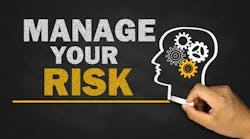Radar “sees” things long before they can be seen with the naked eye. It serves as both an early warning and a tracking device for military and civilian purposes. We all have a personal radar that we actively need to use to warn us of things that can pose a threat to our safety.
No one intentionally wants to injure themselves, but we often don’t fully utilize our personal radar to see hazards, opening the door to near-misses and accidents.
There are, of course, times that our reflexes kick in, and we instinctively change direction when we fear the outcome, i.e.:
- Catching our balance when we slip
- Ducking when something flies at us
- Reacting when another driver cuts us off
Even though we have a natural instinct to help to keep us safe, instinct is not enough. We still do a lot of things without thinking that negatively can affect us. For instance, why would you ever:
- Use a fixed-blade box cutter?
- Not wear personal protective equipment?
- Wear inappropriate footwear on snow or ice?
- Text or use a cell phone while driving?
- Carry items that block your view?
- Lift anything beyond your ability?
- Not report a safety hazard?
- Not think before you act?
- Climb stairs without holding onto the railing?
Why do we so often depend on our reflexes and instincts instead of seeing problems far enough in advance in order to take action before they can harm us?
The simple answer is lack of awareness, some may call it inattention blindness, when we don’t see what’s right in front of us. Awareness can’t be taught. It only can be encouraged and learned from experience, down-to-earth training and information sharing that targets the reasons that cause accidents.
Radar, like most instruments, needs to be calibrated against known standards. On a personal basis, that standard is a personal commitment to awareness.
Sandy Smith, editor-in-chief of EHS Today, summarized the most common accident causes:
- Companies that are complacent about safety
- Employees who are complacent about safety
- Human nature to ignore potential consequences of actions
- Personal protective equipment (PPE) isn’t comfortable
- Work environment not foolproof
To that list, I’d like to suggest the following reasons accidents may occur:
| Anger | Inappropriate clothing | Physical limitations |
| Blind spot | Indecision | PPE (lack of; defective or not worn) |
| Disregarding rules | Lack of training | Rushing |
| Distractions | Lack of guards/barriers | Skipping a step/shortcuts |
| Emotions | Lack of safety culture | Thinking you can multitask |
| Equipment failure | Lack of supervision | Weather conditions |
| Fatigue | Lack of focus | Wrong/damaged tools |
| Failure to compensate | Medication | |
| Failure to recognize | No pre-planning |
We are all human, and we make mistakes and poor choices. What if we could just reduce the risks we face every day, even though we might not be able to completely eliminate them?
By addressing the reasons for accidents, we can improve our state of awareness and, as a result, keep ourselves more alert to safety.
For example, use the act of lifting a box. Seems simple, right? However, suppose the box is on the floor, doesn’t have hand holds and weighs more than you anticipate.
If you bend over, grab the box and lift it, you can put yourself at risk of an injury. If you do this a number of times, it might take just one lift where your back says, “no more” and you have a back sprain, strain or spasm.
The use of punched out hand holds on boxes, checking the weight before lifting, keeping your back straight and lifting with your legs are proven steps toward preventing a back injury. The same type of preparation holds true for any number of daily tasks to insure that you see and think before you act.
The point to be made here is, even if you may not be completely aware all of the time, if you practice things like safe lifting even half the time, you will reduce your risk of injury by 50 percent. The same goes for any number of tasks that you perform every day.
We need to know what the hazards are before we can see and act on them. Hence, the need for sharing of experiences via interactive hazard analysis training as one proactive step toward a safer workplace.
